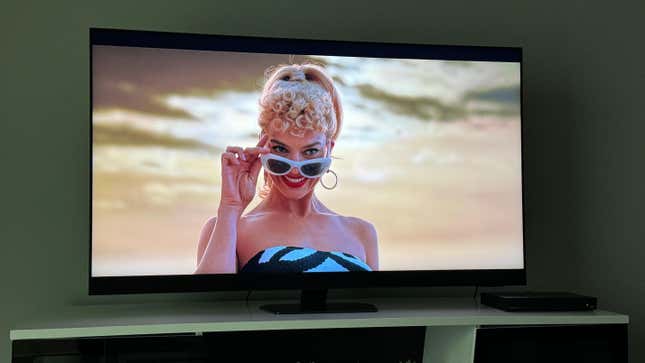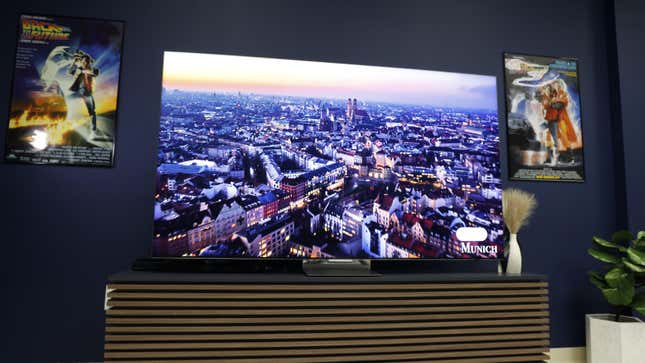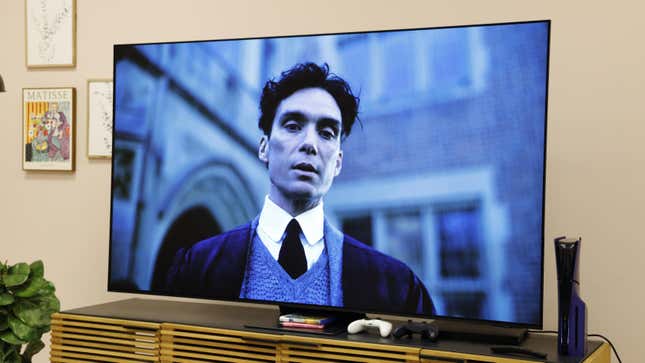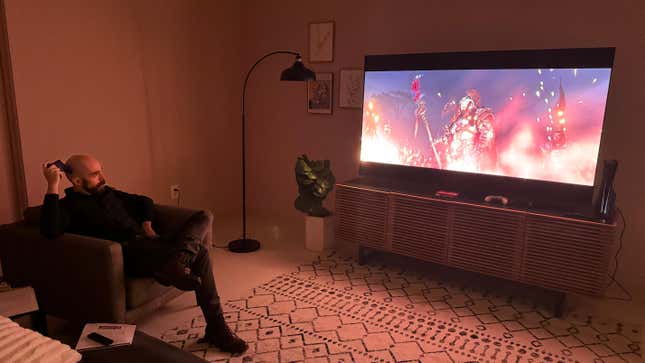The big TV releases for 2024 are finally coming down the pike, and if it wasn’t already clear, this year’s theme is split between AI and displaying the most film-accurate picture for your home display. Samsung’s latest QLED and OLED TVs all emphasize their AI scaling tech, but no matter how much you try to make 4K content look even higher-res, it still comes down to HDR capabilities and each screen’s color quality.
Samsung’s latest TV slate includes a new 4K and 8K Neo QLED and the showstopping S95D OLED model. Gizmodo visited Samsung’s secret lair to check out a few of their latest TV models, including Neo QLEDs in both 4K and 8K varieties and the highlight of the show, which still remains the company’s OLED model.
While we didn’t spend enough time with each screen for a full review, we did sit back and take in the glory of Samsung’s bright new displays. These screens all run Samsung’s own HDR10+. While the company’s proprietary dynamic range tech is great at emphasizing the detail of what’s on screen, you’ll still miss out on the opportunity for Dolby Vision. Screen buffs will form their opinions on which is better, but you’ll still miss it on Samsung’s latest TVs. With that in mind, we still came away satisfied with Samsung’s 2024 lineup, mainly thanks to the company’s gaming-focused software.
Samsung QN90D Neo QLED 4K TV Does the Job and Looks Great Doing it

You can look at the 4K QLED for $1,399 for the QN85D or $1,499 for the QN90D. And if you’re looking for the best bang for your buck, our money’s on the slightly more expensive version. We sat in front of the 65-inch screen, and if you’re still unable to put out the extra several thousand dollars for an OLED, this might be the next best thing.
Like last year’s QN90C, Samsung is putting out all the stops to make its 4K QLEDs the best options for those who don’t want OLED but would still want great contrast. It’s sharp and bright with damn good contrast. We recorded a peak HDR brightness at 521 nits at full screen in Standard mode at default settings. The TV should be brighter under Movie mode and closer to 300 nits under SDR. I couldn’t spot anything wrong with the color gamut or contrast. Really, I couldn’t spot a single thing I didn’t like about Samsung’s latest 4K TV offering. It’s a bright, beautiful display with minimal bezels attached to a very thin frame.
Most users won’t go fiddling with anything beyond basic viewing settings, if at all. Still, Samsung does offer high-tuned light controls for those who need to adjust every aspect of their viewing experience. That’s all before you start looking at the AI enhancements, of which there’s a lot. Most TV makers are promoting their algorithmic auto-adjusting technology, but Samsung claims its Real Depth Enhancer Pro should sharpen images in the foreground of each scene. We watched several 4K movies like Oppenheimer and The Barbie Movie. We couldn’t exactly spot any fuzziness in the background, so while you won’t necessarily notice any AI enhancements going, at the very least, they won’t disrupt your watching experience.
The 2024 4K QLEDs also promote their AI Customization Mode that is supposed to optimize the picture depending on the scene. Again, the only difference we could tell between the new NEO QLED and other TVs is that it still had sharp blacks, and while they weren’t quite the pure black voids you could hope for, there were solid gradients between lights and darks. The big headline feature is still the AI upscaling engine that will take old shows and boost their resolution. We watched some lower-quality content, and yes, it does look good on the big screen, but no, it won’t be a full 4K experience. Overall, it will be better viewing, and that’s all you should expect.
The 4K QLED does have sound, though inevitably, it won’t be as good as a full surround sound setup or even a fair-quality soundbar. The TV boasts a voice amplifier feature that boosts dialogue for easier listening, and there is built-in Dolby Atmos sound for a fair listening experience. It is loud enough, and with such a thin frame, it’s still amazing the sound quality is as good as it is. But if you spend over $1,500 on a TV, you probably have enough for a better sound system anyway.
Samsung QN900D Neo QLED 8K Would Be Great if There Were 8K Content to Watch

Samsung is still betting that the future will lie in ultra-high resolutions, and maybe the company is right. But as of now, despite its strong picture quality and the excellent tech that’s made it into the ultra-high-end 8K TV, we’re still scratching our heads trying to figure out who can make good use of super-scaled content.
Our time in front of the QN900D was equally impressive and confusing. It starts at $4,999 for a 43-inch model, while the QN800D will set you back $3,500 for the same size. Samsung is boasting that its most expensive TV has its most powerful processor, the NQ8 AI Gen3, with a far improved neural processing unit (NPU) meant to handle the 8K AI upscaling and motion-enhancing tech.
That would indeed be something. There are very few examples of pure 8K content that’s honestly worth watching. Samsung did not have any available, save for a brief demo reel that lets you see the very fine details of a head of hair or the true majesty of a mountain range. That’s all well and good, but how well can it truly show 4K content? Is the AI capable of making lower-res content look even better?
We couldn’t tell much difference between Oppenheimer on the 8K screen versus the 4K. We swore we saw minute clarity bumps on the edges of some objects on screen, but if Samsung told me this was upscaling the content to 5K instead of 8K, we’d be more prone to believe it. The other motion capabilities of the QN900D are supposed to emphasize small objects zipping across the screen, so it’s mostly a use case for watching sports in ultra, ultra high definition. We could see the ball of a tennis match smacking the clay of a tennis court, but it’s not like we couldn’t see a similar image on a 4K TV.
None of this is to say it’s a bad-looking TV. Quite the opposite, the same QLED technology still makes a good impression. We recorded a brightness of 715 nits on standard mode, and as you can already guess, the color quality was on par with the 4K model, if not a little better, thanks to the upgraded scale.
Samsung S95D OLED Remains the Pinnacle of Samsung’s HDR10+ Tech

Like the other TVs coming to Samsung’s TV slate, the company’s latest OLED comes in two flavors: the S90D, which starts at $1,999 for 55 inches, and the S95D, which starts at $2,599 for 55 inches. The latest OLED is one of the better examples, thanks to its anti-glare tech that doesn’t mitigate its bright display and excellent contrast.
We stood in a full-lit room and tried shining lights at different ends of the TV, but we couldn’t spot any signs of glare. We should note this was in a complete interior under fluorescent lights and a few lamps of the faux room decor. We couldn’t test whether sunlight beaming in through a nearby window would greatly impact the display, but from what we could see, things were fine. OLED screens already boast no distortion in the image depending on the viewing angle, so the lack of glare would be a nice selling point on Samsung’s latest display.
We couldn’t spot much impact on the display quality, which is good because this is certainly a high-quality OLED display with great color depth and contrast. The blacks are indeed black, with a great color gradient and a bright screen. We recorded 521 nits on standard mode displayed with full screen, but movie settings should bump that up a bit more.
Samsung’s Gaming Features Are Front of the Pack for TVs

Samsung has been trying to pull out all the stops for gamers. For one, there’s the Samsung Gaming Hub built into all its latest TVs. It’s a simple UI that features all the major game services and even a few you’ve probably never heard of. If you haven’t actually used the Samsung Gaming Hub controller, know that it does the job and feels sturdy enough, though I can’t say I’ve spent extensive time with it.
The TVs will automatically recognize when you have a console plugged into them, and the Neo QLED changed its settings once it detected there was a PlayStation 5 on board. The TV does 120 Hz native with a 144 Hz variable refresh rate, which should be good enough for all your console gaming needs as both PS5 and Xbox Series X supports 4K up to 120 Hz refresh rates.
Samsung’s Tizen OS includes an additional built-in Game Mode with an accessible Game Bar that will let you finagle with a few frame rates, resolutions, and frame rate settings. There are a few more AI tricks Samsung is trying to promote on its TVs. The Game Bar 4.0 is supposed to use an AI engine to automatically adjust sound and brightness to emphasize certain screen areas, such as the mini-map on an RPG or the sound of footsteps in a shooter. Could we spot the difference? Not really, and we were looking for it. It’s another one of those features that would be far too annoying if you actually notice it.
Overall, Samsung’s systems are among the most accessible for gaming-minded folks. With the added support, it’s easy to imagine the 4K QLED or the OLED as one of the best options for those who don’t want to spend too much on a TV but still push their console experience to the limit. Then again, we might see 8K support on the PS5 Pro if the rumors are believed. Maybe finally, we’ll see a reason you should spend upwards of $3,500 for the possibility of 8K content if Sony manages to upscale its content to the ludicrous resolution.





















+ There are no comments
Add yours